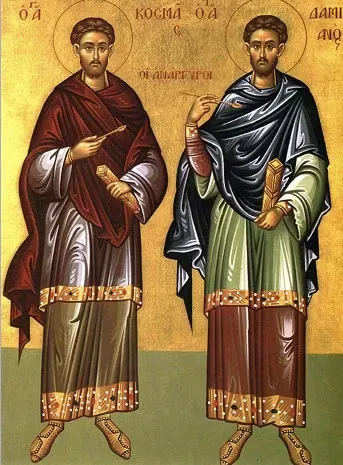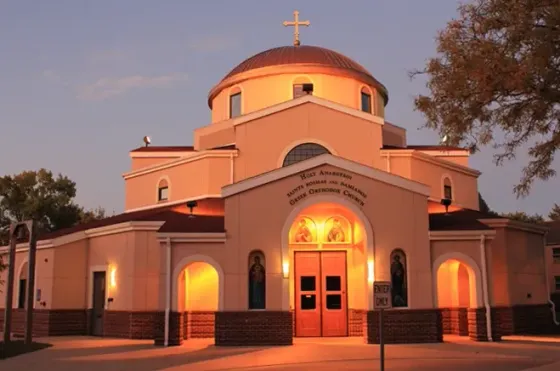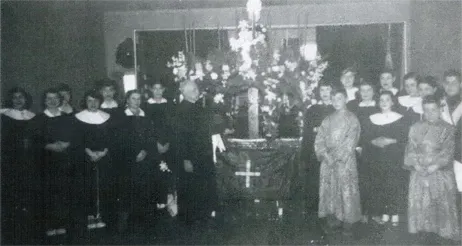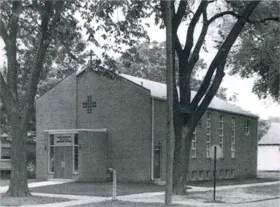About Us
St. Kosmas and Damianos Church is a multi-ethnic parish of Orthodox Christians. We are Orthodox because our tradition of prayer and worship is rooted in the One, Holy, Catholic, and Apostolic undivided Church.
It is important to define our terms. The Orthodox Church was founded by Christ through the Apostles and has maintained a living, historical connection with the Apostolic church through the ordination of its clergy. The fact that the bishop who ordains an Orthodox priest today can trace his ordination historically all the way back to the Apostles, and through them to Christ, is a guarantee that the Orthodox Church was not founded a few centuries or decades ago but by Christ Himself. We call this "Apostolic Succession." It means that the Orthodox Church is the authentic and genuine Church or Body of Christ in the world today. It continues to teach not one man's interpretation of the faith but the complete deposit of faith as it was handed down to the Apostles by Jesus Christ.
One of the distinguishing features of the Orthodox Church is her consistency. The Orthodox Church baptizes by a three-fold immersion as was practiced in the early Church. It still confirms infants at baptism bestowing upon them the "seal of the gift of the Holy Spirit." It still brings babies and small children to receive Holy Communion. In the liturgy the deacon still cries out, "The doors, the doors," recalling early days when none but baptized members of the Christian family could participate in the liturgy. The Nicene-Constantinopolitan Creed is still recited without the later addition. The Orthodox Church has two distinctive features: (1) her changelessness; (2) her sense of living continuity with the church of the Apostles.

Our Saints
Our Parish is named after two Saints from Asia Minor. After the death of their father, their Christ-loving mother Theodota reared them in piety, and in all manner of virtue, and had them instructed in every science especially that of medicine.
This became their vocation (Physicians), and they went about healing every illness and malady, bestowing healing freely on both men and beasts alike; because of this, they are called "Unmercenaries," which means, they did not accept payment for attending to the sick. They worked many miracles as well, and thus, having completed the course of their life they reposed in peace.
Apolytikion in the Plagal of the Fourth Tone
Sainted Unmercenaries and Wonder Workers, regard our infirmities; freely you have received, freely share with us.
Kontakion in the Second Tone
O glorious, wonderworking physicians, having received the grace of healing, you reach out and restore health to those in need. But also, by your visitation you cast down the arrogance of the enemy, healing the world through miracles.
Parish History
1947: AHEPA Hall downtown Rochester
In 1947, twenty-six Greek immigrants gathered for the purpose of establishing an Orthodox Church in Rochester. They began the process of organizing the Greek community to move forward towards securing a state charter. The archdiocese assigned the first spiritual leader in 1948. The first Divine Liturgy was celebrated in the American Hellenic Educational Progressive Association (AHEPA) Hall in downtown Rochester. The Sunday School, a Greek school, and the Choir were also established.
1954: Original Church
The community grew. In 1951, surrounding Rochester communities in southern Minnesota and western Wisconsin became part of the parish. With financial aid by the Order of AHEPA the parish began its dream of constructing a House of Worship - completed in 1954.
After 50 years at the original site and several remodeling projects. The community embarked on a building project. In 2002, the General Assembly approved the construction of our new church. The first Divine Liturgy was celebrated by His Eminence Metropolitan Iakovos of Chicago in October 2004.
His Eminence Bishop Ezekiel of Chicago celebrated the first Divine Liturgy and laying of the cornerstone in 1954. His Eminence Archbishop Michael urged the community to name the church Holy Anargyroi in honor of Sts. Kosmas and Damianos, the Doctors who were also miracle workers providing their services to the sick and infirm without pay. The name ties in with Rochester's fame as a medical city being home to the world renowned Mayo Clinic.
2004: The Current Church
In 2002 the General Assembly approved the building of a new church, completed in 2004. The educational wing was added in 2015.


